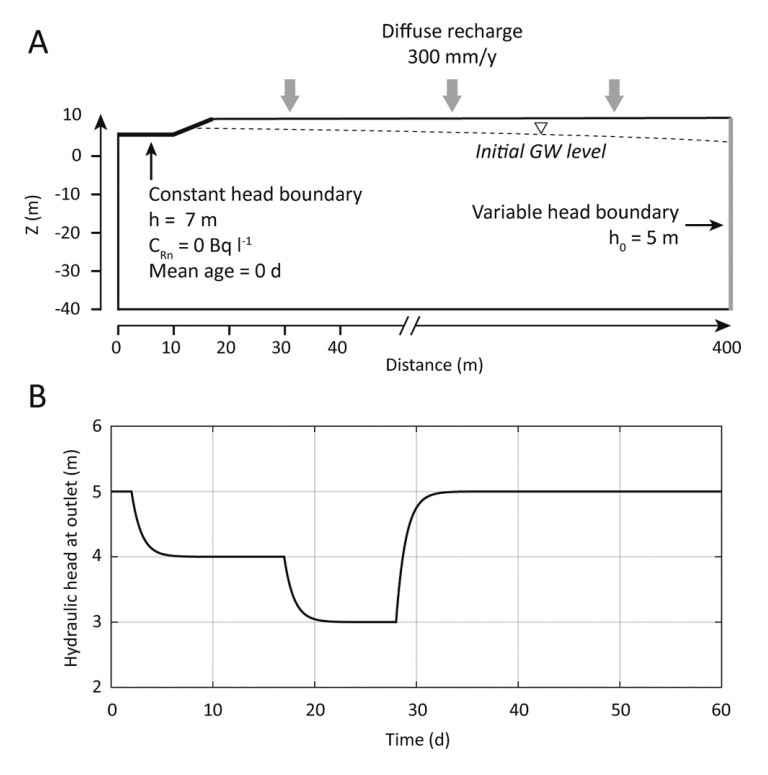HGS RESEARCH HIGHLIGHT – Exploring the reliability of ²²²Rn as a tracer of groundwater age in alluvial aquifers: Insights from the explicit simulation of variable ²²²Rn production
Peel, M., Delottier, H., Kipfer, R., Hunkeler, D., & Brunner, P. (2023). Exploring the reliability of 222Rn as a tracer of groundwater age in alluvial aquifers: Insights from the explicit simulation of variable 222Rn production. In Water Research (Vol. 235, p. 119880). Elsevier BV. https://doi.org/10.1016/j.watres.2023.119880
“The numerical code HydroGeoSphere (Aquanty, 2023) was used, as it is capable of simulating variably-saturated flow and solute transport with both source and decay terms, corresponding respectively to ²²²Rn ingrowth and disintegration. The scope of the 2-D model is to explicitly simulate ²²²Rn signatures in groundwater along multiple flowlines downgradient from the site of infiltration (i.e. a stream or river) in both steady-state and transient hydraulic conditions.”
CLICK HERE TO READ THE ARTICLE.
We’re pleased to highlight this paper which investigates the reliability of using radon-222 (²²²Rn) as a tracer for groundwater age in alluvial aquifers. Accurate estimations of groundwater residence time (GRT)—the time since water infiltrated from the surface—are critical for effective water resource management, especially in systems that rely on bank filtration near rivers for drinking water supply. While ²²²Rn has long been employed as a natural tracer due to its radioactive decay properties and elevated concentrations in groundwater, most traditional models assume spatially uniform ²²²Rn production and purely advective flow— assumptions that rarely hold in real-world aquifers.
This research utilizes HydroGeoSphere (HGS) to simulate coupled groundwater flow, solute transport, and radioactive decay processes within a synthetic two-dimensional alluvial aquifer model. A major advancement of the study lies in its explicit representation of spatially variable ²²²Rn production, based on high-resolution laboratory measurements of emanation rates from aquifer sediments. HGS enabled the researchers to simulate both steady-state and transient flow regimes, incorporating advection, dispersion, and decay dynamics across a heterogeneous domain. By doing so, the model captures how ²²²Rn signatures evolve under realistic hydrological conditions and varying spatial distributions of tracer sources.
Figure 3. Effect of hydraulic conductivity and longitudinal dispersivity on simulated steady-state ²²²Rn concentrations. Results from a single realization of the distribution of ²²²Rn production rates and the six parameter combinations are shown for illustrative purposes. A: Equivalent equilibrium ²²²Rn concentrations in the model domain, shown here as a proxy for ²²²Rn production rates. They represent theoretical equilibrium ²²²Rn activities in saturated conditions without flow or molecular diffusion; B: ²²²Rn activities in steady-state conditions. Black contour lines represent mean groundwater age.
The study reveals that spatial heterogeneity in ²²²Rn production, combined with hydrodynamic mixing, can result in substantial biases in apparent groundwater ages calculated using conventional methods. Specifically, the apparent ages derived from ²²²Rn concentrations may underestimate or overestimate the actual mean residence time depending on aquifer parameters like hydraulic conductivity, dispersivity, and the spatial scale of variability in ²²²Rn production. In simulations where both advection and dispersive mixing are strong, the bias is minimized, and ²²²Rn concentrations more closely reflect average production rates. However, under low-flow or highly heterogeneous conditions, age estimates can deviate significantly— by a factor of two or more— from the true mean groundwater age.
Importantly, the study also demonstrates that while absolute age estimates may be unreliable, relative changes in ²²²Rn-derived apparent ages can still track variations in mean groundwater age during transient conditions. This makes ²²²Rn a potentially valuable tool for monitoring shifts in groundwater flow dynamics over time, even in complex systems.
By leveraging HGS’s capacity for integrated surface-subsurface simulation and its ability to incorporate spatially distributed tracer inputs, this research contributes to a deeper understanding of the limitations and opportunities in using ²²²Rn for groundwater dating. The findings emphasize the need for caution in interpreting ²²²Rn-based ages, particularly in heterogeneous environments, and advocate for the use of physically based modelling approaches like HGS to assess tracer behavior in real-world aquifer systems.
Abstract:
Knowledge of groundwater residence times (GRT; the time elapsed since surface water infiltration) between losing rivers and pumping wells is crucial for management of water resources in alluvial aquifers. The radioactive noble gas radon-222 (²²²Rn) has been used for decades as a natural indicator of surface water infiltration, as it can provide quantitative information on GRT. However, models using ²²²Rn as a tracer of GRT are often based on a set of highly simplifying assumptions, including spatially homogenous ²²²Rn production and exclusively advective mass transport within the aquifer. In this paper, we use the integrated surface-subsurface hydrological model HydroGeoSphere (HGS) to simulate ²²²Rn transport, production, and decay in a bank filtration context. Spatially variable ²²²Rn production, based on experimental data, is explicitly considered. We show that variable ²²²Rn production rates, coupled with hydrodispersive mixing of groundwater, may lead to large biases in GRT estimates. Under certain transient conditions however, changes in tracer-derived GRTs correlate well with changes in mean groundwater age. Whereas ²²²Rn-derived GRTs may only be reliable under a narrow range of field conditions, ²²²Rn may serve as a powerful tracer of changes in mean GRT even in complex and heterogenous environments.



